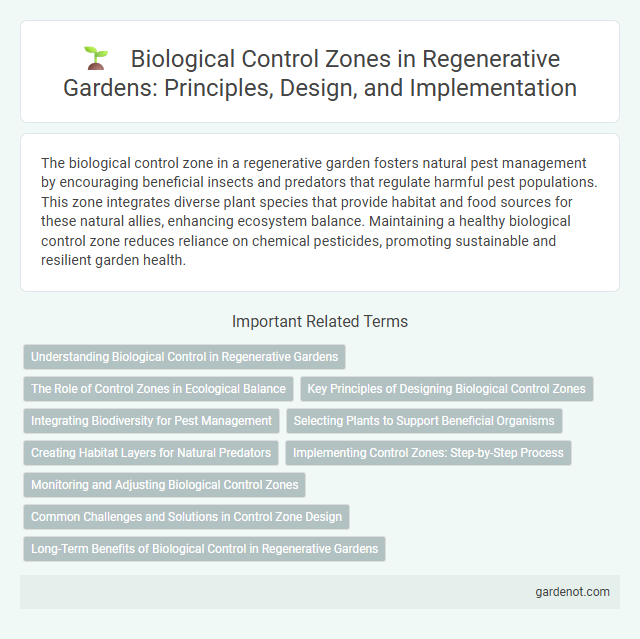The biological control zone in a regenerative garden fosters natural pest management by encouraging beneficial insects and predators that regulate harmful pest populations. This zone integrates diverse plant species that provide habitat and food sources for these natural allies, enhancing ecosystem balance. Maintaining a healthy biological control zone reduces reliance on chemical pesticides, promoting sustainable and resilient garden health.
Understanding Biological Control in Regenerative Gardens
Biological control in regenerative gardens involves using natural predators, parasites, and pathogens to manage pest populations, reducing reliance on chemical pesticides. Establishing a biological control zone enhances ecosystem balance by promoting beneficial insects such as ladybugs, lacewings, and predatory mites. This approach supports soil health and plant resilience by fostering biodiversity and natural pest regulation processes.
The Role of Control Zones in Ecological Balance
Control zones in regenerative gardens create targeted areas where natural predators and beneficial insects regulate pest populations, maintaining ecological balance. These zones minimize the need for chemical interventions by fostering habitats that support biodiversity and promote healthy soil microbiomes. Effective biological control zones enhance resilience against invasive species and contribute to sustainable plant growth.
Key Principles of Designing Biological Control Zones
Designing biological control zones in regenerative gardens involves integrating diverse plant species that attract beneficial predators and parasitoids to naturally suppress pest populations. Emphasizing habitat complexity and continuous food sources ensures ecological balance and resilience against pest outbreaks. Strategic placement of these zones near vulnerable crops maximizes pest control efficiency while promoting soil health and biodiversity.
Integrating Biodiversity for Pest Management
Biological control zones enhance pest management by fostering biodiversity through the introduction of natural predators such as ladybugs, lacewings, and parasitic wasps that target common garden pests. Incorporating diverse plant species attracts beneficial insects and birds, creating a balanced ecosystem that suppresses pest populations naturally. This integration reduces reliance on chemical pesticides, promoting healthier soil and plant resilience within regenerative garden systems.
Selecting Plants to Support Beneficial Organisms
Selecting plants that attract and sustain beneficial insects like ladybugs, lacewings, and parasitic wasps enhances the biological control zone in a regenerative garden. Incorporating flowering plants such as marigolds, dill, and yarrow provides essential nectar and pollen, promoting predator and pollinator populations that suppress pests naturally. Creating diverse plant layers including native shrubs and ground covers further supports habitat complexity, fostering a balanced ecosystem that reduces reliance on chemical interventions.
Creating Habitat Layers for Natural Predators
Creating diverse habitat layers within a biological control zone enhances the presence of natural predators that regulate pest populations. Incorporating ground covers, shrubs, and canopy plants fosters a balanced ecosystem by providing shelter, food sources, and breeding sites for beneficial insects and birds. This multi-layered approach supports sustainable pest management, reducing reliance on chemical interventions in regenerative gardens.
Implementing Control Zones: Step-by-Step Process
Defining Biological Control Zones in a regenerative garden involves mapping distinct areas based on pest populations and beneficial insect habitats to enhance natural predation. Implementing control zones requires targeted planting of companion species, installing insectary plants, and maintaining habitat diversity to support predator-prey balance. Regular monitoring and adaptive management optimize each zone's effectiveness, reducing reliance on chemical pesticides and promoting ecological resilience.
Monitoring and Adjusting Biological Control Zones
Monitoring biological control zones through regular pest and beneficial insect surveillance ensures balanced ecosystems in regenerative gardens. Adjusting control measures based on real-time data optimizes natural predator-prey relationships, minimizing chemical interventions. Effective biological control zones enhance soil health, plant resilience, and overall biodiversity.
Common Challenges and Solutions in Control Zone Design
Common challenges in designing biological control zones for regenerative gardens include managing pest populations without harming beneficial insects and maintaining biodiversity to support natural predators. Solutions involve implementing diverse plant species that attract and sustain beneficial insects, creating habitat refuges, and using targeted release of biological control agents to balance pest dynamics effectively. Integrating monitoring protocols ensures adaptive management, optimizing the control zone's ecological resilience and productivity.
Long-Term Benefits of Biological Control in Regenerative Gardens
Biological control in regenerative gardens enhances pest management by harnessing natural predators and beneficial insects, reducing reliance on chemical pesticides and promoting ecosystem balance. This approach fosters soil health, biodiversity, and resilience against pest outbreaks, contributing to sustainable garden productivity over time. Long-term benefits include improved plant health, increased pollination, and a reduced environmental footprint, ensuring a thriving and self-sustaining garden ecosystem.
Biological control zone Infographic

 gardenot.com
gardenot.com